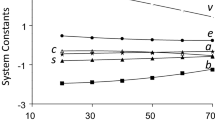Abstract
A phospholipid-modified octadecyl silica (ODS) monolithic column was prepared and its interaction with basic hydrophobic drugs was studied. These drugs are of interest in pharmaceutical research because of their strong interaction with biomembranes. The amount of dimyristoylphosphatidylcholine trapped on the ODS surface was reproducible, and the results of the trinitrobenzenesulfonic acid assay suggested the formation of a monolayer on the surface. Both hydrophobic and electrostatic interactions acted between the model drugs and the phosphatidylcholine. The column was stable for 10 days at least. The column was applied to the affinity screening of basic drugs to phospholipid. Good correlation was obtained between log k and log P for the basic drugs lidocaine, quinidine, propranolol, imipramine, and chlorpromazine. The monolithic silica column allowed highly hydrophobic basic drugs such as imipramine and chlorpromazine to be assayed; these are difficult to analyze by using a conventional particle-packed column. These drugs were clearly separated from acidic drugs naproxen and warfarin on the log k versus log P plots. The thermodynamic studies revealed that the retention of the drug was an enthalpy-driven process, and that the decrease in enthalpy for the phospholipid-modified ODS monolithic column was larger than those for immobilized artificial membrane columns. Our results suggest that the phospholipid-modified ODS monolithic column is applicable to affinity screening of drugs to phospholipids.







Similar content being viewed by others
References
Dorsey JG, Khaledi MG (1993) J Chromatogr A 656:485–499
Ong S, Cal S, Bernal C, Rhee D, Qiu X, Pidgeon C (1994) Anal Chem 66:782–792
Valko K, Du CM, Bevan CD, Reynolds DP, Abraham MH (2000) J Pharm Sci 89:1085–1096
Kamimori H, Konishi M (2002) Biomed Chromatogr 16:61–67
Godard T, Grushka E (2012) J Chromatogr A 1218:1211–1218
Luo H, Zheng C, Cheng Y (2007) J Chromatogr A 1176:100–106
Fiske CH, Subbarow Y (1929) Science 70(1816):381–382
Gruber HJ, Schindler H (1994) Biochim Biophys Acta 1189:212–224
Mafé S, Manzanares JA, Kontturi K (1998) J Electroanal Chem 457:155–162
Lukacova V, Peng M, Fanucci G, Tandlich R, Hinderliter A, Maity B, Manivannan E, Cook GR, Balaz S (2007) J Biomol Screen 12:186–202
Fraceto LF, Pinto LMA, Franzoni L, Braga AAC, Spisni A, Schreier S, de Paula E (2002) Biophys Chem 99:229–243
Siarheyava A, Lopez JJ, Glaubitz C (2006) Biochemistry 45:6203–6211
Evanics F, Prosser RS (2005) Anal Chim Acta 534:21–29
Nerdal W, Gundersen SA, Thorsen V, Høiland H, Holmsen H (2000) Biochim Biophys Acta 1464:165–175
Österberg T, Svensson M, Lundahl P (2001) Eur J Pharm Sci 12:427–439
Barbato F, Caliendo G, La Rotonda MI, Morrica P, Silipo C, Vittoria A (1990) Farmaco 45:647–663
Barbato F, La Rotonda MI, Quaglia F (1997) J Pharm Sci 86:225–229
Avdeef A, Box KJ, Comer JE, Hibbert C, Tam KY (1998) Pharm Res 15:209–215
Buchwald P, Bodor N (1998) Curr Med Chem 5:353–380
Platts JA, Abraham MH, Butina D, Hersey A (2000) J Chem Inf Comput Sci 40:71–80
Jia Z, Mei L, Lin F, Huang S, Killion RB (2003) J Chromatogr A 1007:203–308
Lüllmann H, Wehling M (1979) Biochem Pharmacol 28:3409–3415
Abdiche YN, Myszka DG (2004) Anal Biochem 328:233–243
Kuroda Y, Saito M, Hamaguchi R (2011) J Pharm Sci Res 3:1298–1301
Tsirkin I, Grushka E (2001) J Chromatogr A919:245–254
Ichimori H, Hata T, Matsuki H, Kaneshina S (1998) Biochim Biophys Acta 1414:165–174
Ong S, Pidgeon C (1995) Anal Chem 67:2119–2128
Ottiger C, Wunderli-Allenspach H (1999) Pharm Res 16:643–650
Pidgeon C, Ong S, Choi H, Liu H (1994) Anal Chem 66:2701–2709
Author information
Authors and Affiliations
Corresponding author
Rights and permissions
About this article
Cite this article
Kuroda, Y., Hamaguchi, R. & Tanimoto, T. Phospholipid-Modified ODS Monolithic Column for Affinity Prediction of Hydrophobic Basic Drugs to Phospholipids. Chromatographia 77, 405–411 (2014). https://doi.org/10.1007/s10337-013-2621-5
Received:
Revised:
Accepted:
Published:
Issue Date:
DOI: https://doi.org/10.1007/s10337-013-2621-5




